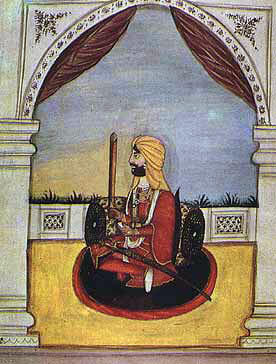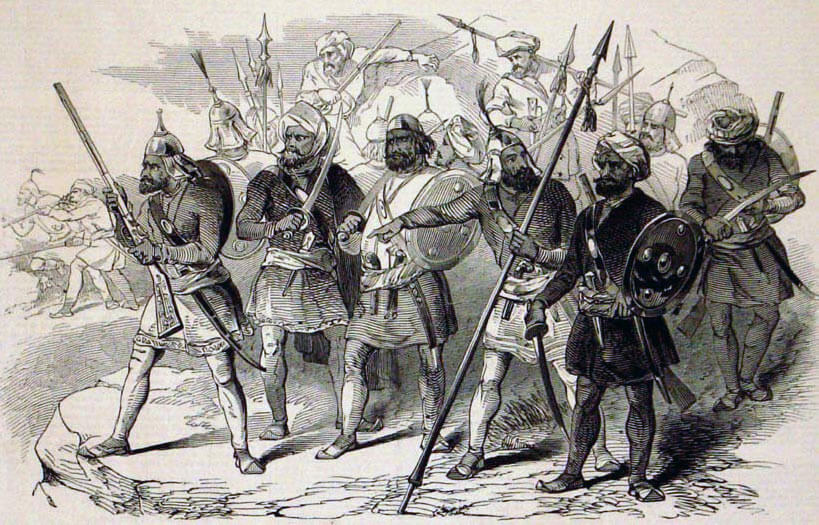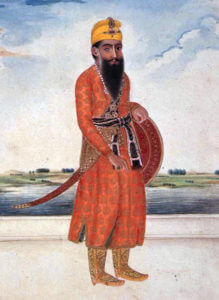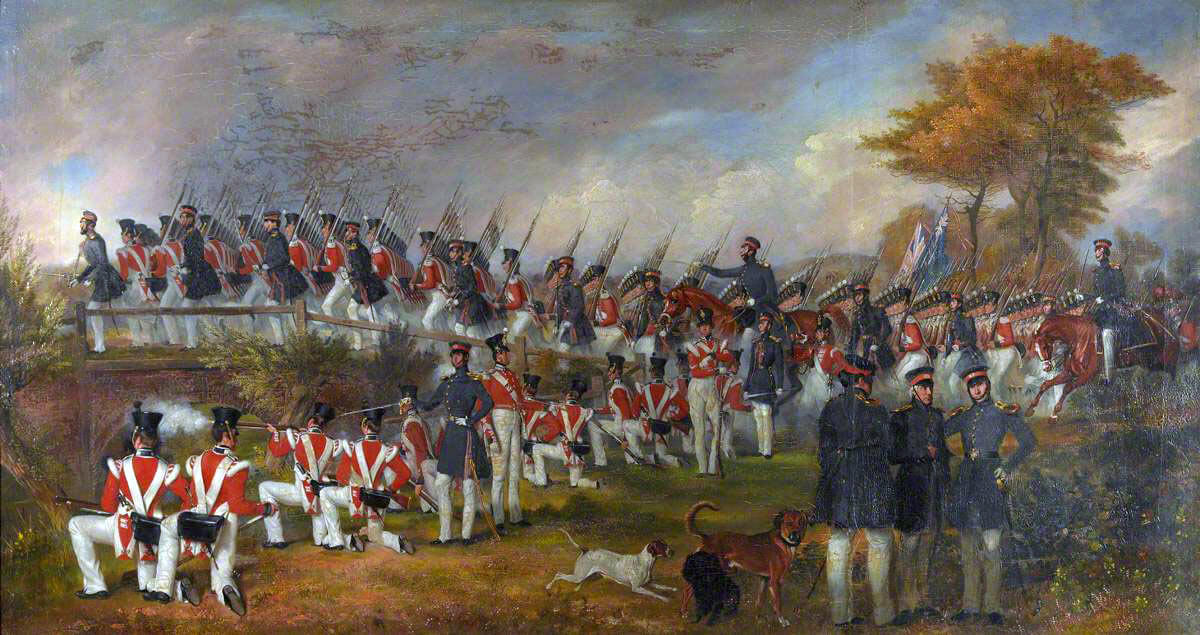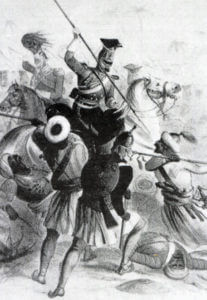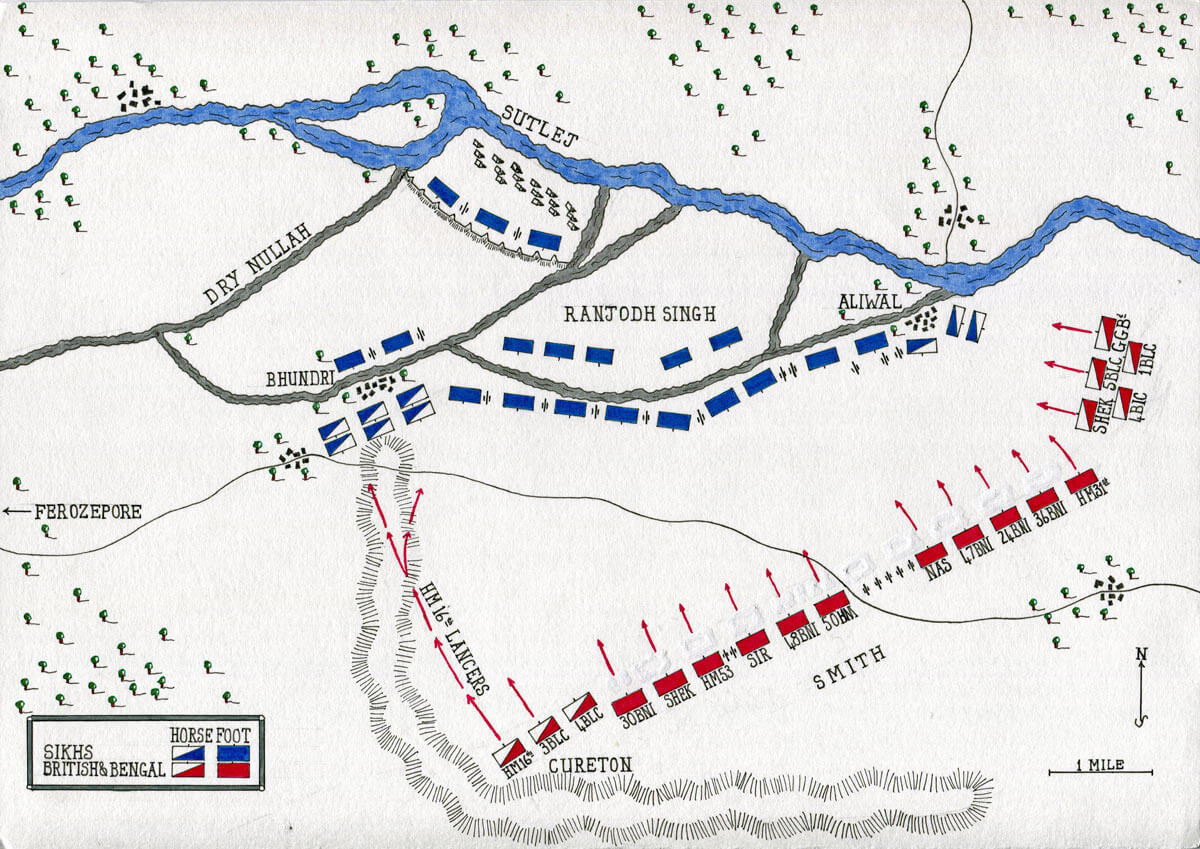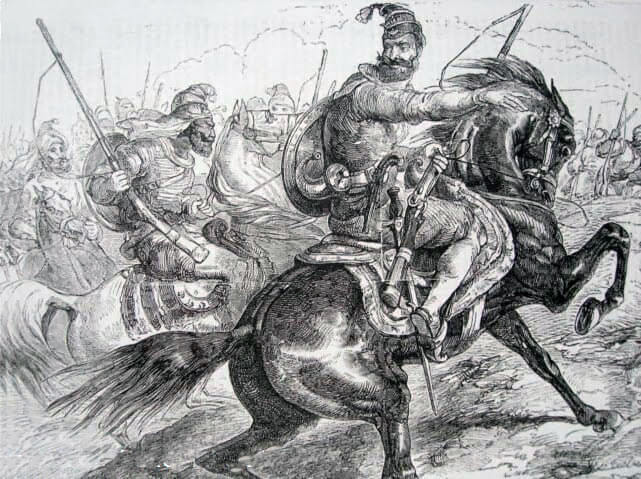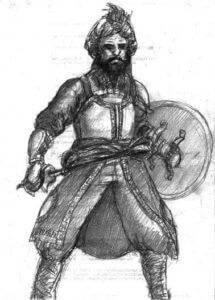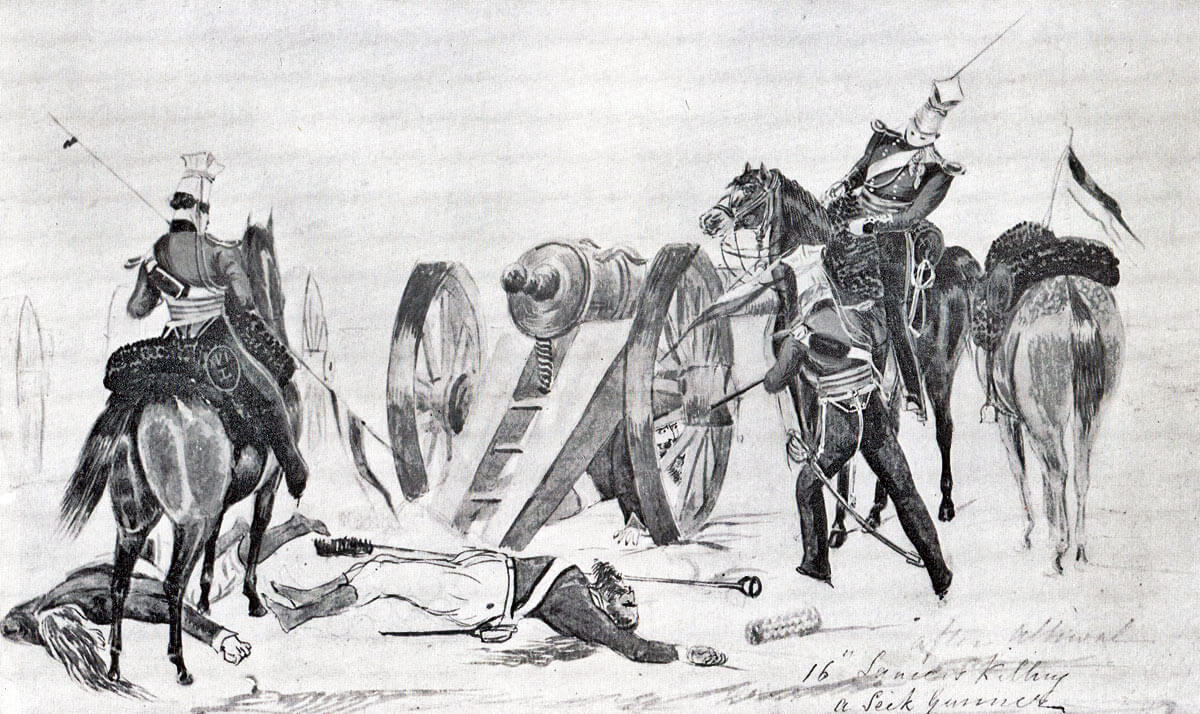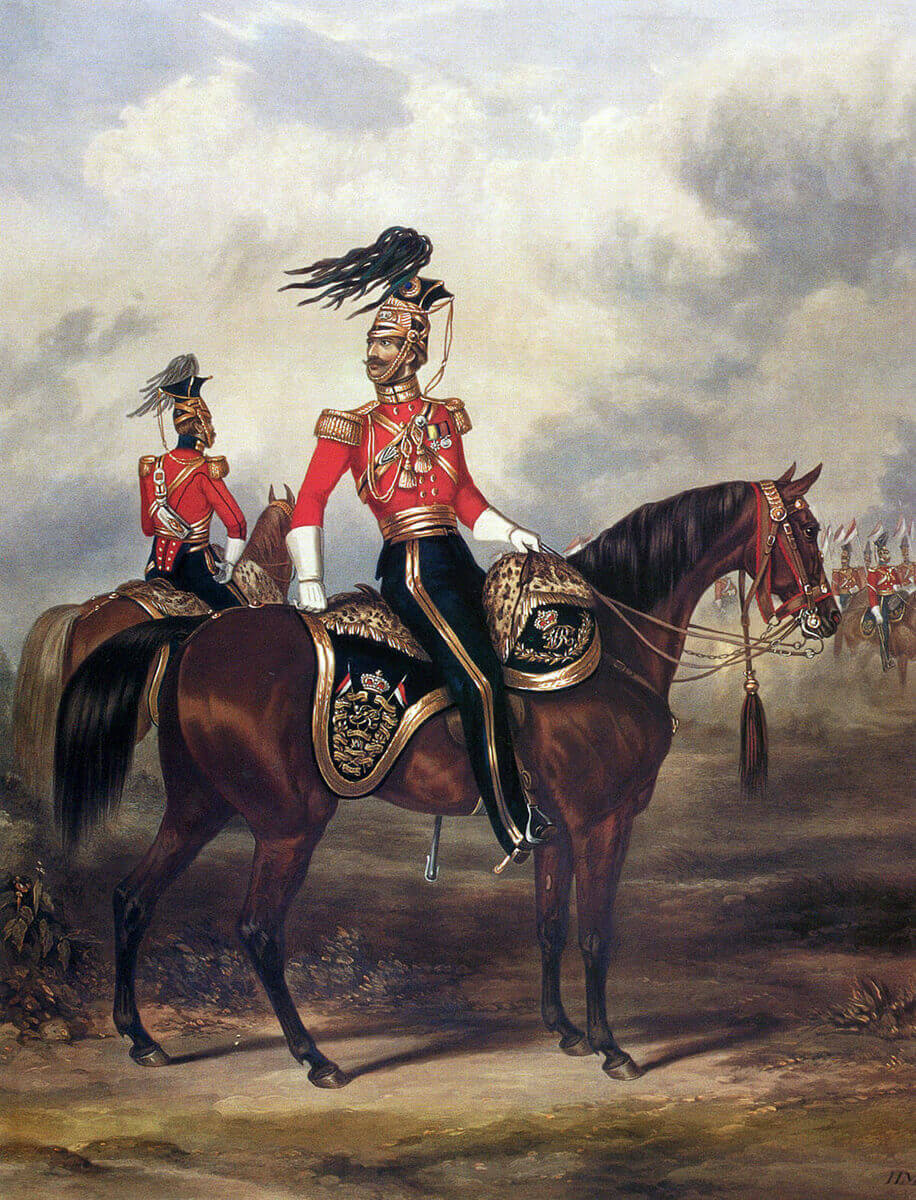Fought on 28th January 1846, described as the ‘near perfect battle’ and scene of the spectacular charge by HM 16th Queen’s Lancers
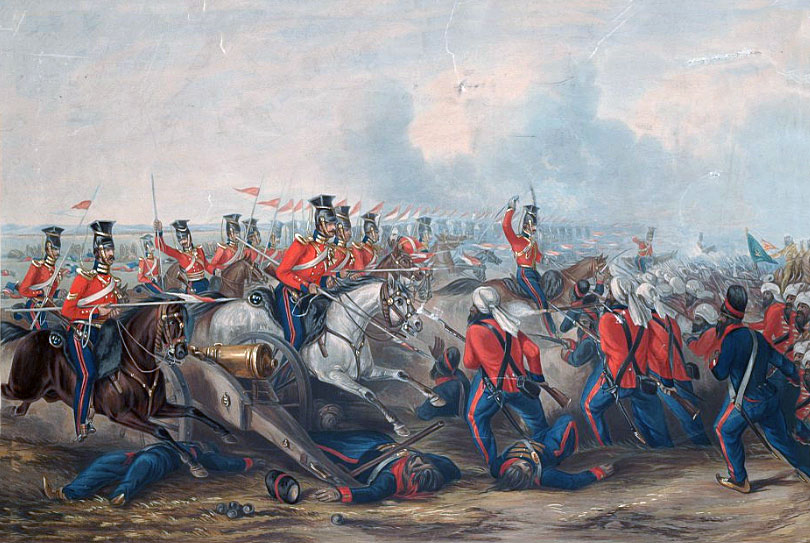
Charge of the 16th Queen’s Lancers at the Battle of Aliwal on 28th January 1846 in the First Sikh War: picture by Martens
The previous battle in the First Sikh War is the Battle of Ferozeshah
The next battle in the First Sikh War is the Battle of Sobraon
Battle: Aliwal
War: First Sikh War.
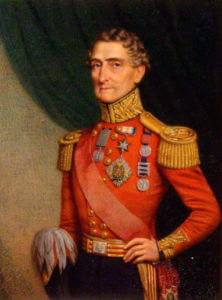
General Harry Smith, British commander at the Battle of Aliwal on 28th January 1846 in the First Sikh War
Date of the Battle of Aliwal: 28th January 1846.
Place of the Battle of Aliwal: In the Punjab in the north-west of India.
Combatants at the Battle of Aliwal: British troops and Indian troops of the Bengal Presidency against Sikhs of the Khalsa, the army of the Punjab.
Commanders at the Battle of Aliwal: General Sir Harry Smith against Ranjodh Singh.
Size of the armies at the Battle of Aliwal: The British and Bengali army of 12,000 men and 30 guns against the Sikh army of 30,000 men and 67 guns.
Uniforms, arms and equipment at the Battle of Aliwal (this section is the same in each of the battles of the Sikh Wars):
The two wars fought between 1845 and 1849 between the British and the Sikhs led to the annexation of the Punjab by the British East India Company, and one of the most successful military co-operations between two races, stretching into a century of strife on the North West Frontier of British India, the Indian Mutiny, Egypt and finally the First and Second World Wars.
The British contingent comprised four light cavalry regiments (3rd, 9th, 14th and 16th Light Dragoons- the 9th and 16th being lancers) and twelve regiments of foot (9th, 10th, 24th, 29th, 31st, 32nd, 50th, 53rd, 60th, 61st, 62nd and 80th regiments).
The bulk of General Gough’s ‘Army of the Sutlej’ in the First Sikh War and ‘Army of the Punjab’ in the Second Sikh War comprised regiments from the Bengal Presidency’s army: 9 regular cavalry regiments (the Governor-General’s Bodyguard and 1st, 3rd, 4th, 5th, 6th, 7th, 8th and 11th Bengal Light Cavalry), 13 regiments of irregular cavalry (2nd, 3rd, 4th, 7th to 9th and 11th to the 17th Bengal Irregular Cavalry), 48 regiments of foot (1st to 4th, 7th, 8th, 12th to 16th, 18th, 20th, 22nd, 24th to 27th, 29th to 33rd, 36th, 37th, 41st to 54th, 56th, 59th, 63rd and 68th to 73rd Bengal Native Infantry), horse artillery, field artillery, heavy artillery and sappers and miners.
The Bombay presidency contributed a force that marched in from Scinde, in the west, and gave considerable assistance at the Siege of Multan; the 19th Bombay Native Infantry gaining the title of the Multan Regiment for its services in the siege, a label still held by its Indian Army successor.
A Bombay brigade under Brigadier Dundas joined General Gough’s army for the final battle of the Second Sikh War at Goojerat, where the two regiments of Scinde Horse, Bombay Irregular Cavalry, particularly distinguished themselves. The brigade comprised: 2 regiments of Scinde Horse, 3rd and 19th Bombay Native Infantry and Bombay horse artillery and field artillery.
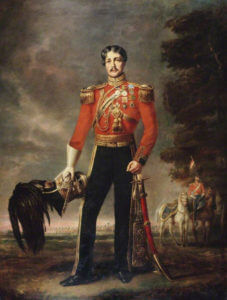
Lieutenant Colonel George Mouat-MacDowell 16th Queen’s Light Dragoons (Lancers): Battle of Aliwal on 28th January 1846 in the First Sikh War
Each of the three presidencies, in addition to their native regiments, possessed European infantry, of which the 1st Bengal (European) Infantry, 2nd Bengal (European) Light Infantry and 1st Bombay (European) Fusiliers took part in the Sikh Wars.
Other corps fought under the British flag, such as the Shekawati cavalry and infantry and the first two Gurkha regiments: the Nasiri Battalion (later 1st Gurkhas) and the Sirmoor Battalion (later 2nd Gurkhas).
General Gough commanded the British/Indian army at 6 of the 7 major battles (not the Battle of Aliwal). An Irishman, Gough was immensely popular with his soldiers, for whose welfare he was constantly solicitous. The troops admired Gough’s bravery, in action wearing a conspicuous white coat, which he called his ‘Battle Coat’, so that he might draw fire away from his soldiers.
Gough’s tactics were heavily criticised, even in the Indian press in letters written by his own officers. At the Battles of Moodkee, Sobraon and Chillianwallah, Gough launched headlong attacks, considered to be ill-thought out by many of his contemporaries. Casualties were high and excited concern in Britain and India. By contrast, Gough’s final battle, Goojerat, which decisively won the war, cost few of his soldiers their lives and was considered a model of care and planning.
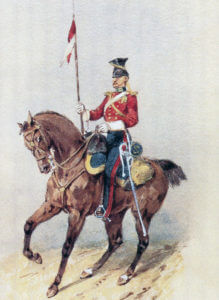
Trooper of HM 16th Lancers: Battle of Aliwal on 28th January 1846 in the First Sikh War: picture by Orlando Norie
Every battle saw vigorous cavalry actions, with HM 3rd King’s Own Light Dragoons and HM 16th Queen’s Royal Lancers particularly distinguishing themselves. The British light cavalry wore embroidered dark blue jackets and dark blue overall trousers, except the 16th who bore the sobriquet ‘the Scarlet Lancers’ for their red jackets. The headgear of the two regiments of light dragoons was a shako with a white cover; the headgear of the lancers the traditional Polish tschapka.
HM regiments of foot wore red coats and blue trousers with shakos and white covers.
The Bengal and Bombay light cavalry regiments wore pale blue uniforms. The infantry of the presidency armies wore red coats and peak less black shakos.
The weapons for the cavalry were the lance for the lancer regiments and sword and carbine for all; the infantry was armed with the Brown Bess musket and bayonet.
Commands in the field were given by the cavalry trumpet and the infantry drum and bugle.
In the initial battles, the Sikh artillery outgunned Gough’s batteries. Even in these battles and in the later ones, the Bengal and Bombay horse and field artillery were handled with great resource and were a major cause of Gough’s success.
Many of the more senior British officers had cut their military teeth in the Peninsular War, and at the Battle of Waterloo: Gough, Hardinge, Havelock of the 14th Light Dragoons, Cureton, Dick, Thackwell and others. Many of the younger men would go on to fight in the Crimea and the Indian Mutiny.
The Sikhs of the Punjab looked to the sequence of Gurus for their spiritual inspiration, and had established their independence, fiercely resisting the Moghul Kings in Delhi and the Muslims of Afghanistan. The Sikhs were required by their religion to wear the ‘five Ks’, not to cut their hair or beard and to wear the highly characteristic turban, a length of cloth in which the hair is wrapped around the head.
The Maharajah of the Punjab, Ranjit Singh, whose death in 1839 ended the Sikh embargo on war with the British, established and built up the powerful Sikh Army, the ‘Khalsa’, over the twenty years of his reign. The core of the ‘Khalsa’ was its body of infantry regiments, equipped and trained as European troops, wearing red jackets and blue trousers. The Sikh artillery was held in high esteem by both sides. The weakness in the Sikh army was its horse. The regular cavalry regiments never reached a standard comparable to the Sikh foot, while the main element of the mounted arm comprised clouds of irregular and ill-disciplined ‘Gorcharras’.
The traditional weapon of the Sikh warrior is the ‘Kirpan’, a curved sword kept razor sharp and one of the ‘five Ks’ a baptised Sikh must wear. In battle, at the first opportunity, many of the Sikh foot abandoned their muskets and, joining their mounted comrades, engaged in hand to hand combat with sword and shield. Horrific cutting wounds, severing limbs and heads, were a feature of the Sikh Wars, in which neither side gave quarter to the enemy.
It had taken the towering personality of Ranjit Singh to control the turbulent ‘Khalsa’, he had established. Ranjit Singh’s descendants found the task beyond them and did much to provoke the outbreak of the First Sikh War, in the hope that the Khalsa would be cut down to size by the armies of the British East India Company. The commanders of the Sikh armies in the field rarely took the initiative in battle, preferring to occupy a fortified position and wait for the British and Bengalis to attack. In the opening stages of the war there was correspondence between Lal Singh and the British officer, Major Nicholson, suggesting that the Sikhs were being betrayed by their commander.
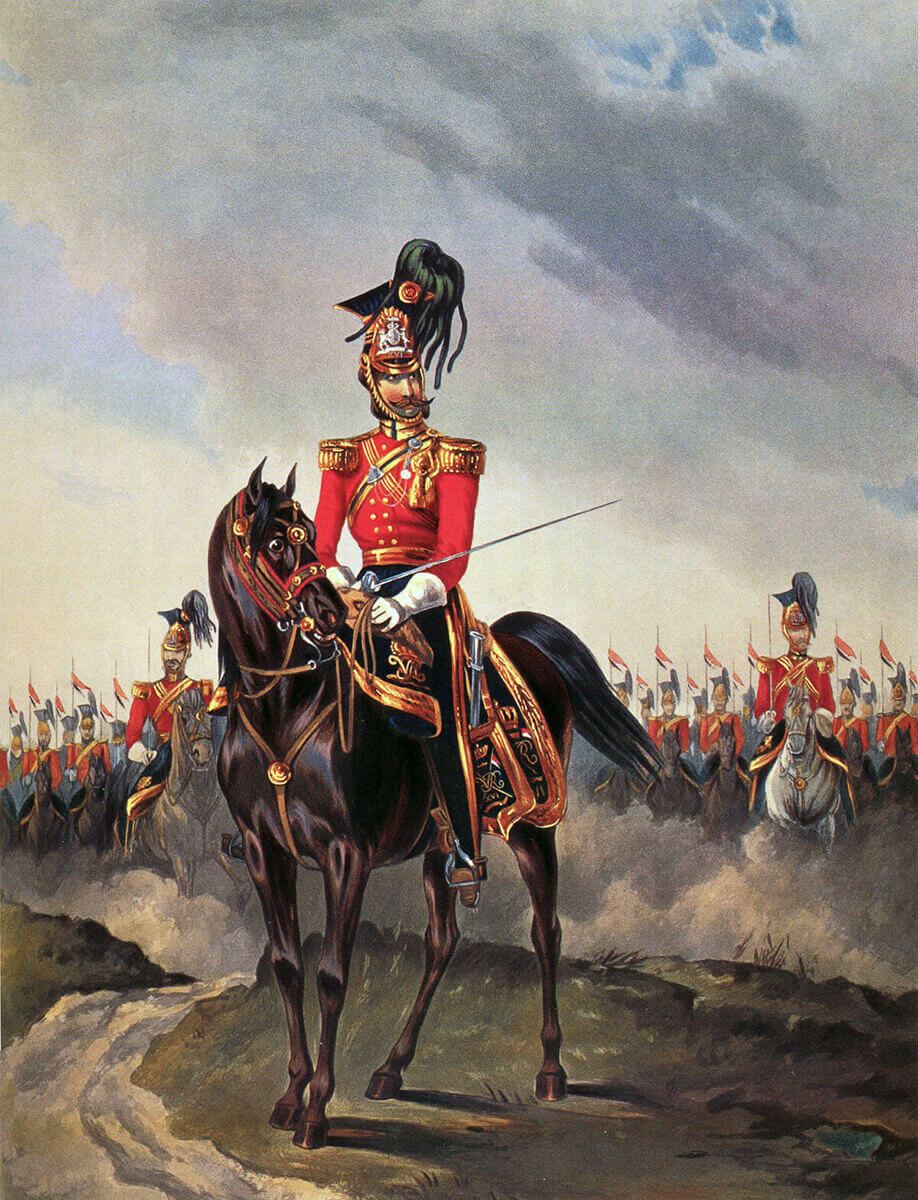
16th Queen’s Lancers: Battle of Aliwal on 28th January 1846 in the First Sikh War: print by Ackermann
Pay in the Khalsa was good, twice the rate for sepoys in the Bengal Army, but it was haphazard, particularly after the death of Ranjit Singh. Khalsa administration was conducted by clerks writing in the Persian language. In one notorious mutiny over pay, Sikh soldiers ran riot looking for anyone who could, or looked as if they could, speak Persian, and putting them to the sword.
The seven battles of the war and the siege of the city of Multan were hard fought. Several of the battle fields were wide flat spaces broken by jungly scrub, from which the movement of large bodies of troops in scorching heat raised choking clouds of dust. As the fighting began, the dust clouds intermingled with dense volumes of musket and cannon smoke. With the thunder of gunfire and horses’ hooves, the battle yells and cries of the injured, the battles of the Sikh Wars were indeed infernos.
Winner of the Battle of Aliwal: The British and Bengali troops of General White’s army.
British and Indian Regiments at the Battle of Aliwal:
British:
HM 16th Queen’s Light Dragoons (Lancers), now the Queen’s Royal Lancers. *
HM 31st Foot, later the East Surrey Regiment and now the Princess of Wales’s Royal Regiment.*
HM 50th Foot, later the Queen’s Own Royal West Kent Regiment and now the Princess of Wales’s Royal Regiment.*
HM 53rd Foot, later the King’s Shropshire Light Infantry and now the Rifles.*
Army of Bengal:
Governor General’s Bodyguard.*
1st Bengal Native Cavalry.*
3rd Bengal Native Cavalry.*
5th Bengal Native Cavalry.*
4th Irregular Cavalry.*
Shekawati Cavalry.*
3 Batteries of Horse Artillery.*
2 Field Batteries of Artillery.*
24th Bengal Native Infantry.*
36th Bengal Native Infantry.*
47th Bengal Native Infantry.*
48th Bengal Native Infantry.*
Nasiri Gurkha Battalion.*
Sirmoor Gurkha Battalion.*
The Indian Army regiments:
Cavalry:
The Governor General’s Bodyguard continues as the President of India’s Bodyguard.*
4th Bengal Irregular Cavalry in1861 became 3rd Bengal Cavalry, in 1903 3rd Skinner’s Horse and in 1922 1st Duke of York’s Own Skinner’s Horse.*
All the regular Bengal cavalry regiments that fought at Aliwal ceased to exist in 1857.
Infantry:
47th Bengal Native Infantry in1861 became the 7th Bengal Light Infantry, in 1903 7th Duke of Connaught’s Own Rajputs in 1903 the 3rd Battalion (Duke of Connaught’s Own) the 7th Rajput Regiment and from 1950 the 3rd Battalion, the Rajput Regiment of the Indian Army.*
Nasiri Gurkha Battalion in 1861 became 1st Gurkha Light Infantry, in 1910 became 1st King George V’s Own Gurkha Rifles (the Malaun Regiment) and in 1947 became 1st Gurkha Regiment of the Indian Army.*
Sirmoor Gurkha Battalion in 1861 became 2nd Gurkha Rifles and in 1906 2nd King Edward VII’s Own Gurkha Rifles (the Sirmoor Regiment) and in 1947 was transferred to the British Army.*
The remaining Bengal infantry regiments that fought at Aliwal ceased to exist in 1857.
*These regiments have Aliwal as a battle honour.
Order of battle of General Smith’s army at the Battle of Aliwal:
Commander: General Sir Harry Smith.
Cavalry Division: Brigadier General Cureton.
Brigadier Macdowell’s brigade: HM 16th Queen’s Lancers, 3rd Bengal Light Cavalry and 4th Bengal Irregular Cavalry.
Brigade Stedman’s brigade: Governor General’s bodyguard, 1st Bengal Light Cavalry, 5th Bengal Light Cavalry and Shekawati Cavalry.
Horse Artillery: Major Laurenson, 3 batteries.
Infantry Division:
1st Brigade: HM 31st Foot, 24th and 47th Bengal Native Infantry.
2nd Brigade: Brigadier Wheeler; HM 50th Foot, 48th Bengal Native Infantry and Sirmoor Battalion of Gurkhas.
3rd Brigade: Brigadier Wilson; HM 53rd Foot and 30th Bengal Native Infantry.
4th Brigade: Colonel Godby; 36th Bengal Native Infantry and Nasiri Battalion of Gurkhas.
Artillery: 2 field batteries and 2 eight-inch howitzers.
Account of the Battle of Aliwal:
Following the Battle of Ferozeshah, Tej Singh withdrew his Sikh army across the Sutlej River, while General Sir Hugh Gough formed his force on the south bank and awaited reinforcements.
Seeing this inactivity on the part of the British and Bengali army, Tej Singh detached Ranjodh Singh with 8,000 troops and 70 guns to march east along the river and cross, so as to menace the British base at Ludhiana, thereby causing Gough great concern, as a large slow column of supplies with the British siege train was coming up from the east.
Gough dispatched General Sir Harry Smith with a brigade of infantry, cavalry and guns, to clear the Sikhs away from his line of communication and prevent the Sikhs from taking Ludhiana.
Smith, with little difficulty, captured two small forts occupied by the Sikhs on the south bank of the Sutlej River, Fategarh and Dharmkot, and moved on towards Ludhiana. Ahead of him, Ranjodh Singh was following much the same route, but with little apparent urgency.
Gough reinforced Smith with HM 16th Lancers and another battery of guns, and ordered him to march to Jagraon, on the more southerly road, where he was to take under his command HM 53rd Foot. He was then to march to Ludhiana, where he would find Colonel Godby with four native regiments, including two battalions of Gurkhas (later the 1st and 2nd Gurkha Rifles), and four guns.
Ranjodh Singh, being still on the riverside road leading to Ludhiana, stopped and dispersed his army across the countryside. Smith sent word to Godby, to join him at the village of Suneth for a joint assault on the Sikhs. Smith left his baggage under guard at Jograon, and, in the early hours of 21st January 1846, marched out to join Godby.
While on the march, word reached Smith that further Sikh forces had come up, giving Ranjodh Singh around 10,000 troops and 40 guns, and that the Sikhs were marching to cut the route from Jograon to Ludhiana at Baddowal.
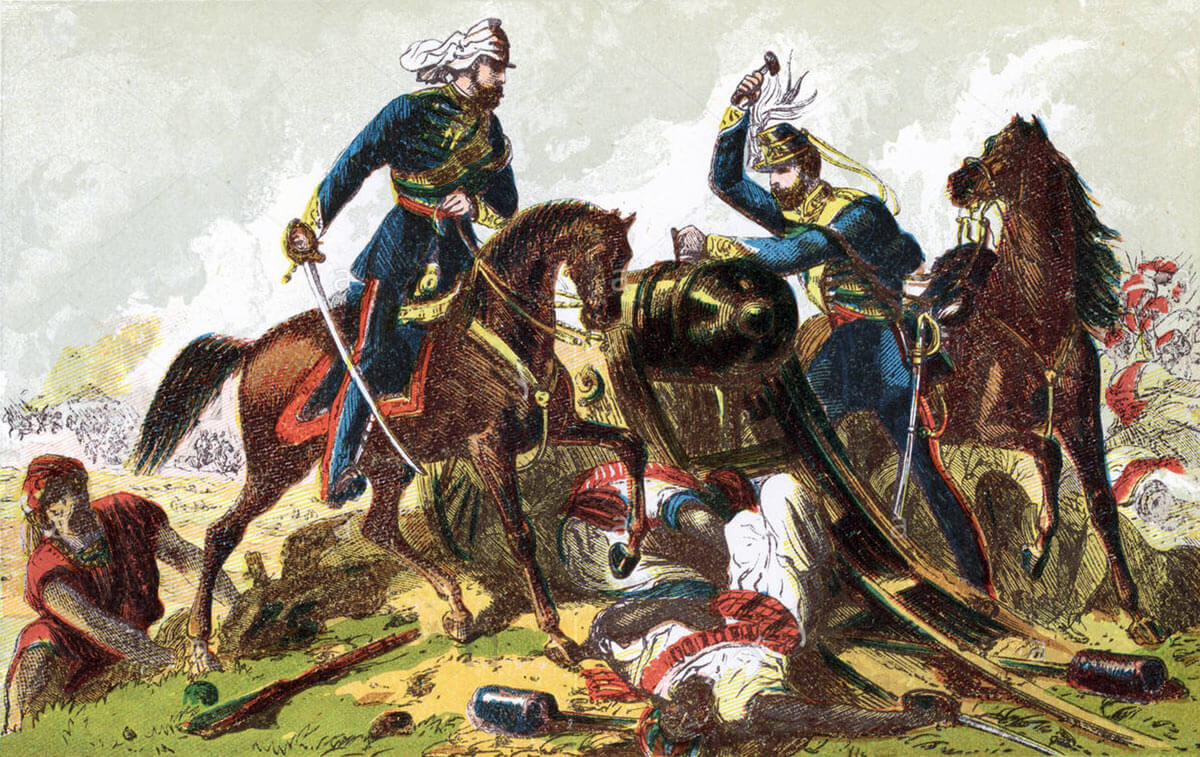
Light Dragoons spiking a Sikh gun at the Battle of Aliwal on 28th January 1846 in the First Sikh War
In the light of the strength of Ranjodh Singh’s army, Smith resolved to march around it and on to Ludhiana, which he managed to achieve, even though the Sikhs had the benefit of being on the road. The British and Bengali infantry reached Ludhiana in a state of exhaustion, many of the foot soldiers carried by the cavalrymen on their horses.
Smith found that Godby was still at Ludhiana. After a day’s rest for his troops, Smith marched out to attack Ranjodh Singh at Baddowal, but found that the Sikhs had left to return to the Sutlej, where more troops were crossing the river to join them.
Smith received further reinforcements from Gough, and, now having 12,000 men and 32 guns, marched north in pursuit of Ranjodh Singh.
The reinforcement that had crossed the Sutlej to join the Sikh army was the Avitabile Regiment, a crack Sikh infantry corps trained by the Italian mercenary, General Avitabile. With this addition, Ranjodh Singh was poised to take the offensive, when Smith’s army came up with him in his fortified position between the villages of Aliwal and Bhundri, his back to the River Sutlej.
Smith formed his army, with the cavalry in the rear and the infantry of two brigades, Wheeler’s and Wilson’s, in the first line, supported by two further brigades, Godby’s and Hick’s, in the second, and continued his advance.
At a range of 600 yards, the Sikh artillery opened fire along the length of their position, causing Smith to halt and consider what move to make next.
Smith directed Godby and Hicks to move out from the second line, storm Aliwal on the right and then attack the Sikh line in enfilade. These two brigades took Aliwal and turned towards the Sikh centre, at which, Ranjodh Singh brought up a body of cavalry to restore his collapsing flank.
Brigade Cureton launched Brigadier Stedman’s cavalry brigade, comprising 5th Bengal Light Cavalry, the Bodyguard, 1st Bengal Light Cavalry, 4th Bengal Irregular Cavalry and the Shekawati Cavalry, in a series of charges against the Sikh horsemen, driving them back from Aliwal, and leaving Godby free to advance beyond the Sikh line, towards their camp on the bank of the Sutlej, at the point where the fords gave Ranjodh Singh’s army the only escape route across the river.
Under the pressure of this attack, the Sikh line swung back along the river bank, pivoting on the village of Bhundri.

Charge of the 16th Queen’s Lancers at the Battle of Aliwal on 28th January 1846 in the First Sikh War: first picture by Orlando Norie
A force of cavalry emerged into the plain beyond Bhundri to threaten the British and Bengali flank. Brigadier Cureton ordered Captain Bere’s squadron of HM 16th Queen’s Lancers and the 3rd Bengal Light Cavalry to drive this force back. It is said, but with little authority, that the 3rd did not press home their attack, unlike Bere’s lancers, who charged the Sikh horsemen with great violence and hunted them to the bank of the Sutlej.
Returning from their charge, Bere’s squadron encountered the Avatabile Regiment of infantry, which formed to receive cavalry; the formation being a triangle, rather than a square. Again, the squadron charged home, despite receiving a devastating volley, and broke up the Sikh infantry.
The second squadron of the left flank of HM 16th Lancers, commanded by Captain Fyler, charged further battalions of the Avatabile Regiment, breaking them up.
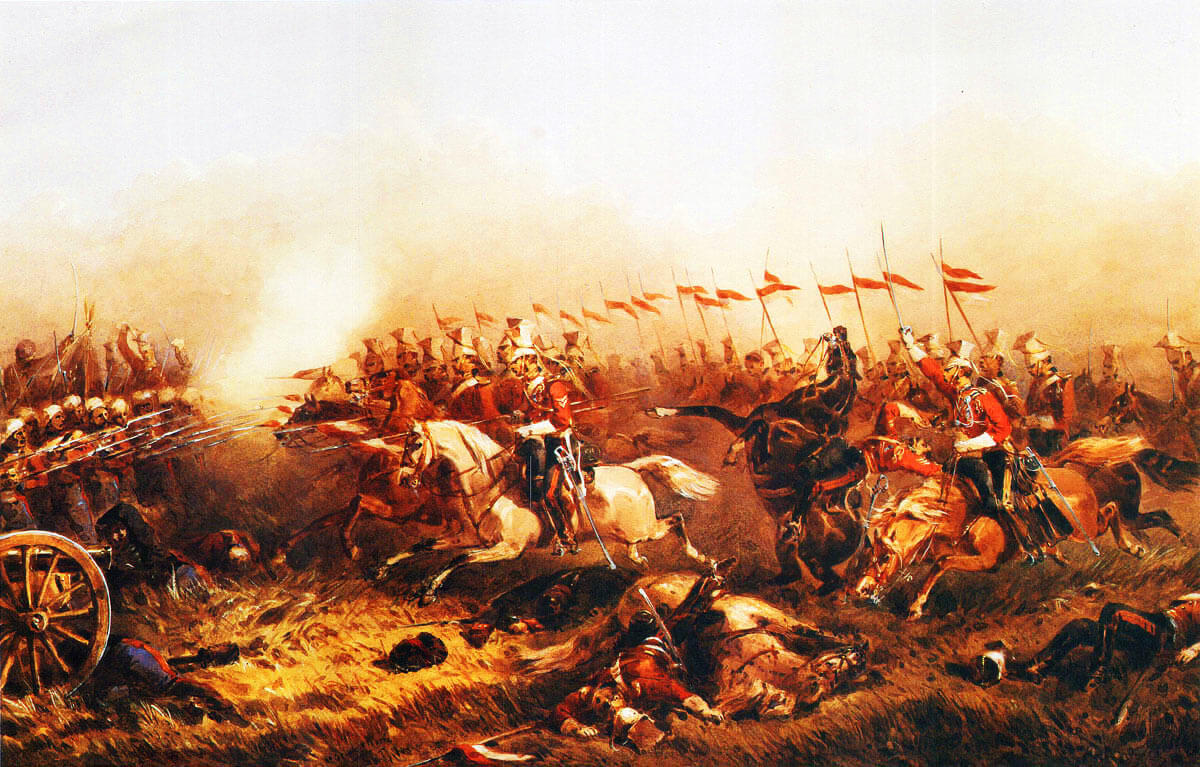
Charge of the 16th Queen’s Lancers at the Battle of Aliwal on 28th January 1846 in the First Sikh War: second picture by Orlando Norie: Sergeant Newsome is in the foreground
Two horse artillery guns, acting in support of the wing, unlimbered and opened fire on the remains of the Sikh regiment, completing its ruin.
Meanwhile, the right wing of the 16th Lancers, commanded by Major Smyth, charged another battalion of Sikh infantry and a battery of guns, Smith beginning the attack with three rousing cheers for the Queen. In this charge, many of the soldiers and officers became casualties.
General Smith met the squadrons of the 16th Lancers, fighting back through the Sikh line, and called out ‘Well done 16th’. Smith ordered the survivors of the right wing to join Bere’s squadrons and the whole regiment delivered a last devastating charge, capturing the village of Bhundri and driving the garrison to the river bank.
HM 53rd Foot came up behind the cavalry, and cleared Bhundri of the remaining determined pockets of Sikhs.
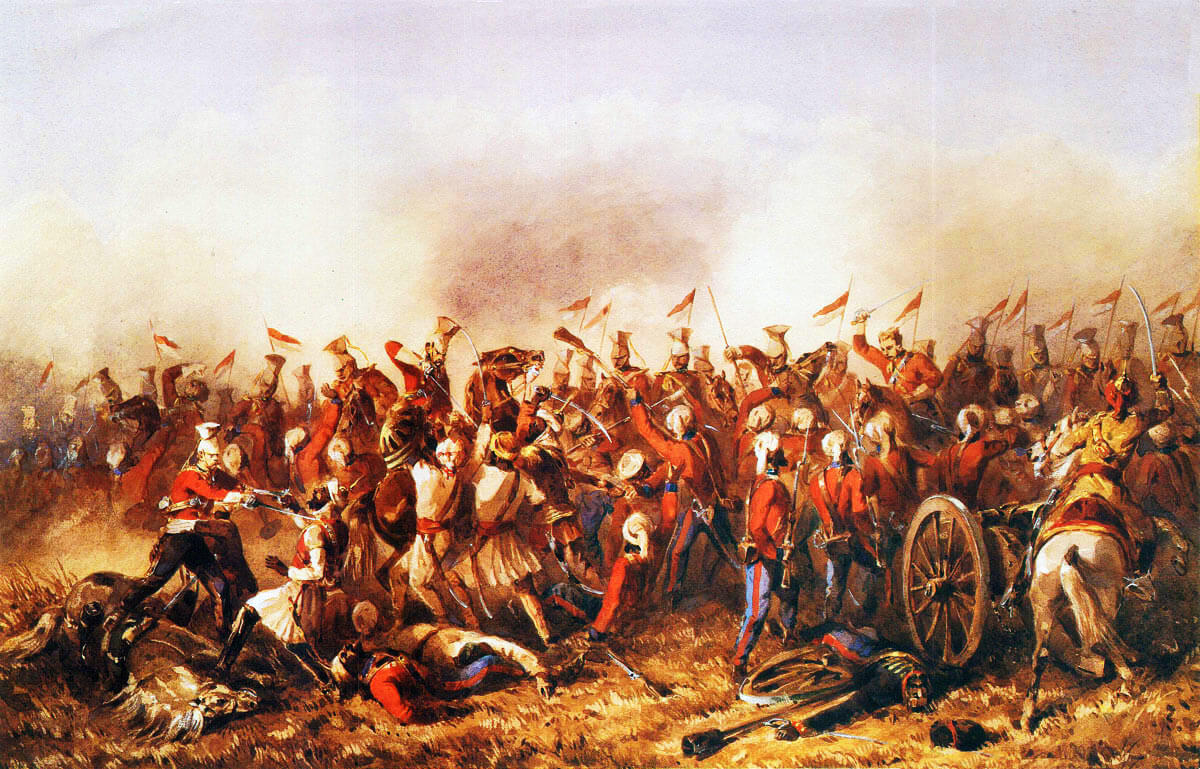
Charge of the 16th Queen’s Lancers at the Battle of Aliwal on 28th January 1846 in the First Sikh War: third picture by Orlando Norie
While the cavalry fights were raging on the flanks, the British and Bengali infantry regiments, supported by artillery, pressed over the fortifications, forcing the Sikh troops back to the Sutlej; a large force being driven out of a nullah by the 30th Bengal Native Infantry into the path of a barrage of grape from 12 guns; ‘unkennelling them’ as General Smith described the feat.
As the Sikh regiments took to the fords to escape across the Sutlej, a battery of nine Sikh guns unlimbered on the river bank to cover the retreat, firing only one salvo before being overrun by the pursuing British and Bengali troops.
Ranjodh Singh attempted to bring some of his guns back across the river, but only two reached the far bank, two more being abandoned in the stream and a further two sunk irretrievably in quicksand.
On the far bank, Ranjodh Singh formed a new line but his troops were quickly dispersed by artillery fire.

Death of Cornet Bigoe-Williams of HM 16th Lancers at the Battle of Aliwal on 28th January 1846 in the First Sikh War: picture by Orlando Norie
Casualties at the Battle of Aliwal: General Sir Harry Smith’s army suffered 589 casualties. The casualties were spread evenly through all the units, provoking the admiration of the Duke of Wellington for Smith’s use of all arms of his army. The only exception was HM 16th Lancers which suffered 144 casualties. The Sikhs admitted to 3,000 killed and lost all their 67 guns, camp equipment and baggage.
Follow-up to the Battle of Aliwal:
Following the Battle of Aliwal, the Sikhs abandoned all their positions south of the Sutlej, other than Sobraon, and crossed the river. With the safe arrival of the siege train, Gough moved to attack the Sikh stronghold of Sobraon.
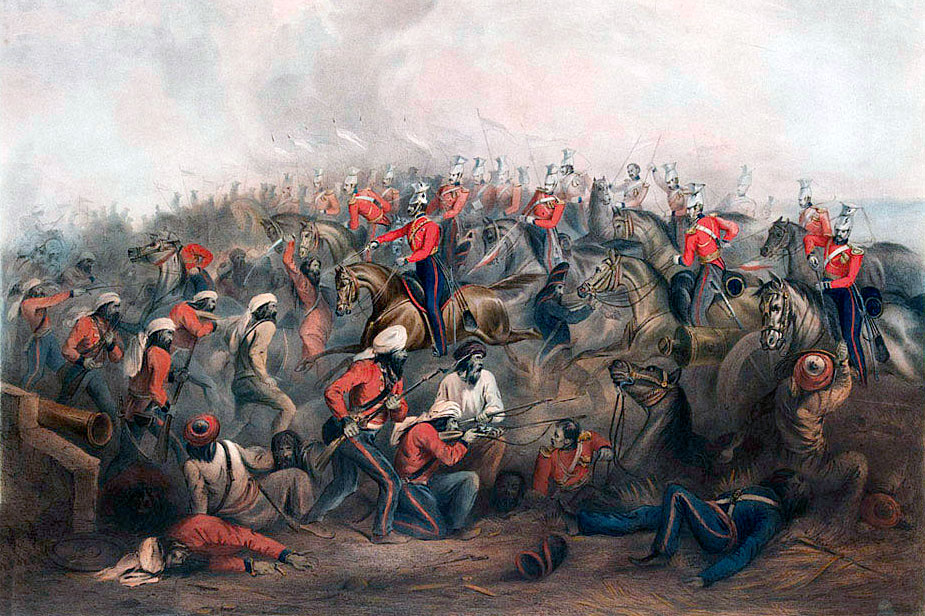
HM 16th Lancers at the Battle of Aliwal on 28th January 1846 in the First Sikh War: picture by Henry Martens
Anecdotes and traditions from the Battle of Aliwal:
- At the Battles of Moodkee and Ferozeshah, the Bengal sepoys and the sowars of the cavalry regiments showed a marked reluctance to engage the feared Sikh soldiers. The Battle of Aliwal changed this, the Bengalis attacking the Sikhs with great élan, driving them across the river in flight.
- HM 16th Lancers was the second British cavalry regiment to win acclaim in the Sikh Wars, after HM 3rd King Light Dragoons at Moodkee and Ferozeshah.
- The 16th Lancers took to crimping their lance pennons in commemoration of the battle, after which it is said that the pennons were stiffened with blood. On the other hand, there is convincing evidence that the troopers of the regiment preferred to discard their lances and fight with the sword, as a more effective weapon. ‘A’ Squadron of the Queen’s Royal Lancers still crimps its lance pennons in memory of the battle.
- One of the officers of the 16th Lancers at Aliwal was Lieutenant William Morris. Nine years later, in 1854, as Captain Morris, he commanded the 17th Lancers in the Charge of the Light Brigade at the Battle of Balaclava. While in India, Morris became close friends with Lieutenant Lewis Nolan, the staff officer who precipitated the Great Charge. At the commencement of the Charge, Nolan rode beside his friend at the head of the 17th Lancers, before becoming one of the first casualties to the Russian guns.
- Sir Harry Smith’s dispatch for the Battles of Aliwal and Sobraon said of Brigadier Cureton, ‘The manner in which this famous officer handles his cavalry, under the hottest and most galling fire, ranks him amongst the first cavalry officers of his age.
- Major Smyth, who commanded the 16th Queen’s Lancers at the Battle of Aliwal, was considered a character. Over six foot in height, he had, in 1831, been committed to prison for a year for killing an opponent in a duel. The regiment gave him leave of absence, and Smyth returned to duty, after completing his sentence, ending his army career as a lieutenant-general.
- The charge of the right wing of HM 16th Lancers is said to have been led by a Sergeant Newsome, who shouted out ‘Hullo boys, here goes for death or a commission.’ Sergeant Newsome leapt his horse over the kneeling front rank of Sikh infantry and went to grab a Sikh colour. He was killed by nineteen bayonet wounds. It is reported that the squadron managed to break into the square, because Newsome’s horse was so fiery and ill-trained that it went straight through the infantry. Peacetime cavalry training had horses breaking around an infantry square, which made it difficult to persuade them to do otherwise in a real battle.
- General Sir Harry Smith, who commanded the British and Bengal troops at the Battle of Aliwal, fought through the Peninsular War in the 95th. After the storming of Badajoz in 1812, a Spanish lady sought protection from the rampaging British troops. Smith married the lady, who became the Lady Smith after whom the Natal town was named.
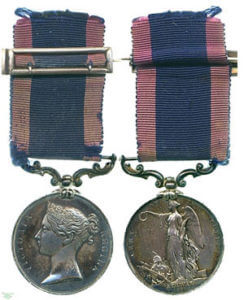
Sutlej campaign medal of Captain Lawrence Fyler of HM 16th Queen’s Lancers engraved with the Battle of Aliwal, now in the Fitzwilliam Museum in Cambridge
Medals and decorations: British and Indian soldiers who took part in the First Sikh War received the medal entitled ‘Sutlej Campaign, 1845-6’.
Where a soldier took part in one or more battles, his medal would have the first battle inscribed on the reverse side of the medal and the remaining battles on clasps on the ribbon.
The battles being described as: ‘Moodkee 1845’, ‘Ferozeshuhur 1845’, ‘Aliwal 1946’ and ‘Sobraon 1846’.
Description of the medal:
Obverse. -Crowned head of Queen Victoria. Legend: ‘Victoria Regina.’
Reverse. -Victory standing beside a trophy, holding a wreath in her outstretched hand. Inscription: ‘Army of the Sutlej.’
Mounting. -Silver scroll bar and swivel.
Ribbon: Dark blue with crimson edges. 1 ¼ inches wide.
References for the Battle of Aliwal:
History of the British Army by Fortescue.
History of British Cavalry by the Marquis of Anglesey.
The previous battle in the First Sikh War is the Battle of Ferozeshah
The next battle in the First Sikh War is the Battle of Sobraon
